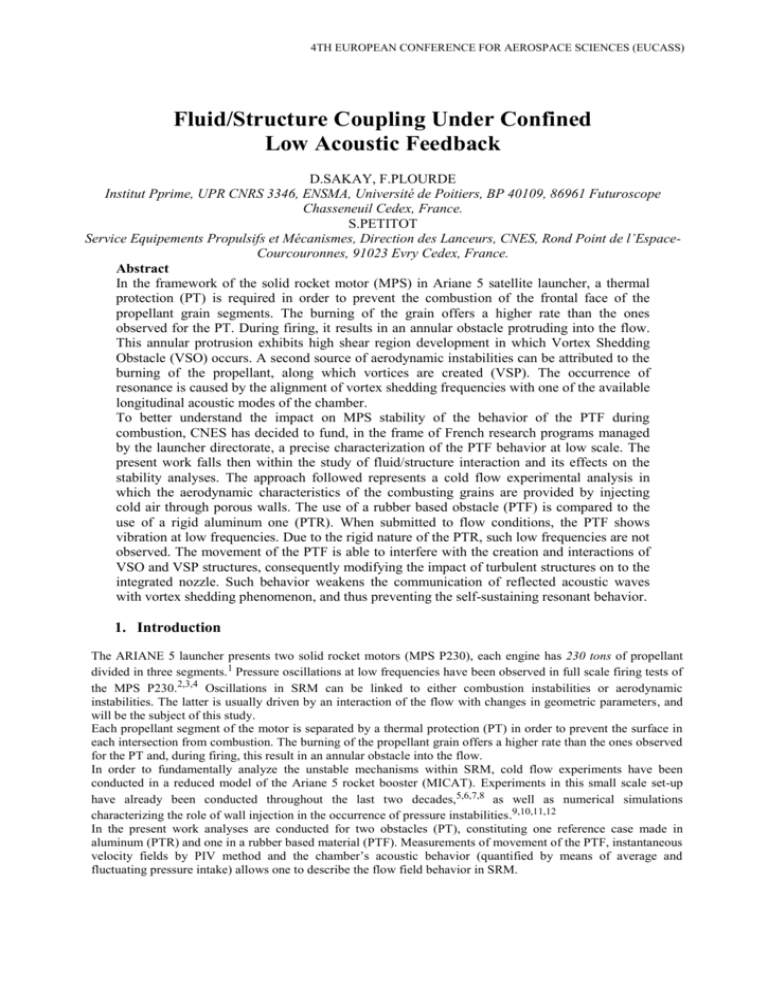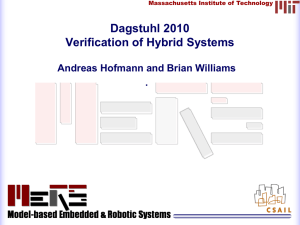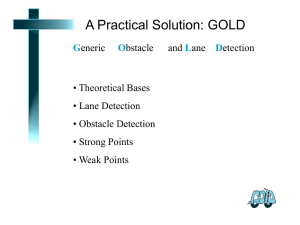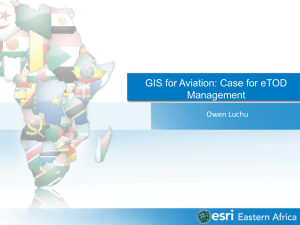Fluid/Structure Coupling Under Confined
advertisement

4TH EUROPEAN CONFERENCE FOR AEROSPACE SCIENCES (EUCASS) Fluid/Structure Coupling Under Confined Low Acoustic Feedback D.SAKAY, F.PLOURDE Institut Pprime, UPR CNRS 3346, ENSMA, Université de Poitiers, BP 40109, 86961 Futuroscope Chasseneuil Cedex, France. S.PETITOT Service Equipements Propulsifs et Mécanismes, Direction des Lanceurs, CNES, Rond Point de l’EspaceCourcouronnes, 91023 Evry Cedex, France. Abstract In the framework of the solid rocket motor (MPS) in Ariane 5 satellite launcher, a thermal protection (PT) is required in order to prevent the combustion of the frontal face of the propellant grain segments. The burning of the grain offers a higher rate than the ones observed for the PT. During firing, it results in an annular obstacle protruding into the flow. This annular protrusion exhibits high shear region development in which Vortex Shedding Obstacle (VSO) occurs. A second source of aerodynamic instabilities can be attributed to the burning of the propellant, along which vortices are created (VSP). The occurrence of resonance is caused by the alignment of vortex shedding frequencies with one of the available longitudinal acoustic modes of the chamber. To better understand the impact on MPS stability of the behavior of the PTF during combustion, CNES has decided to fund, in the frame of French research programs managed by the launcher directorate, a precise characterization of the PTF behavior at low scale. The present work falls then within the study of fluid/structure interaction and its effects on the stability analyses. The approach followed represents a cold flow experimental analysis in which the aerodynamic characteristics of the combusting grains are provided by injecting cold air through porous walls. The use of a rubber based obstacle (PTF) is compared to the use of a rigid aluminum one (PTR). When submitted to flow conditions, the PTF shows vibration at low frequencies. Due to the rigid nature of the PTR, such low frequencies are not observed. The movement of the PTF is able to interfere with the creation and interactions of VSO and VSP structures, consequently modifying the impact of turbulent structures on to the integrated nozzle. Such behavior weakens the communication of reflected acoustic waves with vortex shedding phenomenon, and thus preventing the self-sustaining resonant behavior. 1. Introduction The ARIANE 5 launcher presents two solid rocket motors (MPS P230), each engine has 230 tons of propellant divided in three segments.1 Pressure oscillations at low frequencies have been observed in full scale firing tests of the MPS P230.2,3,4 Oscillations in SRM can be linked to either combustion instabilities or aerodynamic instabilities. The latter is usually driven by an interaction of the flow with changes in geometric parameters, and will be the subject of this study. Each propellant segment of the motor is separated by a thermal protection (PT) in order to prevent the surface in each intersection from combustion. The burning of the propellant grain offers a higher rate than the ones observed for the PT and, during firing, this result in an annular obstacle into the flow. In order to fundamentally analyze the unstable mechanisms within SRM, cold flow experiments have been conducted in a reduced model of the Ariane 5 rocket booster (MICAT). Experiments in this small scale set-up have already been conducted throughout the last two decades,5,6,7,8 as well as numerical simulations characterizing the role of wall injection in the occurrence of pressure instabilities.9,10,11,12 In the present work analyses are conducted for two obstacles (PT), constituting one reference case made in aluminum (PTR) and one in a rubber based material (PTF). Measurements of movement of the PTF, instantaneous velocity fields by PIV method and the chamber’s acoustic behavior (quantified by means of average and fluctuating pressure intake) allows one to describe the flow field behavior in SRM. 4TH EUROPEAN CONFERENCE FOR AEROSPACE SCIENCES (EUCASS) Vortex shedding in the wake of the obstacle generates turbulent structures (VSO). A second vortex shedding mechanism arises along the injecting walls (VSP). The two mechanisms (VSO and VSP) can merge together and may align with the longitudinal acoustic modes of the test chamber, emphasizing a resonant phenomenon.13,14,15,16 Recent studies17 have shown that the physic properties and consequently the vibration mode of an emerging thermal protection can influence the VSO generation and it's interaction with VSP by forcing a fluid-structure coupling. Therefore, movement of the PTF has a significant influence on the flow organization and is the main issue of this research. By means of direct pressure fluctuation acquisition, the so-called “end of combustion” configuration is identified as a resonant case i.e. strong acoustic and velocity correlation arises. Consequently, this experiment condition has been considered as a reference case for the analyses of fluid/structure interaction. In order to render possible PIV seeding concomitant with air injection, dedicated porous walls have been used. However, such a change has a direct impact on the acoustic isolation, characterizing a low acoustic feedback behavior. 2. Experimental Set-up The experiment is conducted in a 1/40 scaled model of the Ariane 5 SRM P230. Figure 1 shows representations of the experimental set-up, in which the propellant grain combustion is simulated by a cold gas injection through porous bronze plates adapted to three injecting blocks. The air intake passes through a system of polyamide tubes adapted with sonic nozzles. Under specific pressure conditions, these area reductions provide a uniform mass flow rate distribution. Air is screened, filtrated and separated ensuring an equal flux distribution along the porous walls. This composition induces a perpendicular injection that simulates the propellant burning. The second and third injection blocks are separated by an aluminum obstacle (reference case). The latter is assumed rigid and has a natural frequency higher than the one of the first acoustic mode of the i.e. no interaction may occur. To introduce potential fluid/structure interactions, the rigid obstacle has been replaced by a rubber based material of the same size and slightly different thickness with its natural frequency close to the first acoustic mode The pressure data is acquired by use of two piezoelectric quartz sensors, these sensors are located near the inlet section and work in a range of 0-10 bar with 0.015 mbar pressure accuracy. The vibration of the obstacle was analyzed by laser vibrometry. The acquisition was carried out during a time corresponding to 30720 time-steps. The data was divided in 200 points each composed by an average of 153 blocks (defining a resolution of 2.5 Hz applied to a 0 to 500 Hz spectral range). The instantaneous velocity measurements are obtained by means of a high speed PIV system. Due to the need of particles seeding in the PIV visualization, a low acoustic feedback set-up has been studied. The injecting conditions at porous walls are characterized by providing a 98% filtering of 8.5 µm sized particles. Previous experiments (high acoustic feedback) only refer to grade 3 bronze porous plates providing a 98 % filtering of 0.7 µm particles. The flow speed was kept constant at M=0.09. A 1000 Hz sample rate frequency is sustained along 6 seconds resulting in 6000 images. A multi-pass method is used with a reduction of the interrogation window and with a window overlap of 50 % in both passes. A medium filter was set to strongly remove and iteratively replace by interpolation any groups of spurious vectors, allowing calculations of averages and standard deviation. 3. Results Experiments in a fully acoustically isolated (i.e. with grade 3 porous walls) set-up have been carried out. These preliminary tests were conducted with pressure acquisition in order to correctly perceive the occurrence of a resonant behavior. Figure 2-a and 2-b display respectively the pressure spectral response recorded at the head-end for the high-resonant (rigid obstacle) and low-resonant (flexible obstacle) cases, being both fully acoustically isolated configurations. It is clear in both cases that one simple frequency emerges in the spectral answer. The latter is found close to a frequency that corresponds to the first longitudinal acoustic mode of the chamber. For M 0.09, one can detect a linear increase of such peak despite low energy levels. For 0.09 M 0.105, a jump in frequency first occurs and is followed by another linear increase. In the fully resonant case, as shown in Figure 2-a, it is obvious that such frequency induces significant amplified levels underlining the development of a resonant phenomena. Figure 2-b reveals the output obtained for the low resonant case, in which one can easily notice a significant weakening in spectral energy even though the network of pressure response is similar. To highlight our purpose, Figure 3 shows the spectral answer contained in the pressure fluctuation at M=0.09 for both high and low-resonant cases. While the first acoustic mode is significantly marked for the high-resonant case, the maximum peak amplitude is reduced by a significant factor for the low-resonant set-up. Such a behavior can be attributed to a diminution in dynamic/acoustic coupling 4TH EUROPEAN CONFERENCE FOR AEROSPACE SCIENCES (EUCASS) mechanisms. In the light of a higher acoustic feedback, the role of a flexible obstacle in the energy reduction is then confirmed. In order to explain such a change in fluctuation activity it is first necessary to underline that the flexible obstacle is bent under the flow load. One could then suppose that an inclination of the obstacle may be the main cause of the reduced energy levels, i.e. by modifying vortices issued from the shear-layer as well as their interaction with the injecting flow. However, Nunes18 conducted experiments with a rigid and bent obstacle and no such reductions were observed. In order to confirm their previous assumptions, the authors performed measurements with the use of a vibrating system adapted to a rigid obstacle. By forcing the obstacle vibration through a range of specific frequencies it was concluded that a movement of the latter does change the acoustic response. Having confirmed that the vibration of the obstacle is in fact responsible for the diminution of fluctuating activities, a series of experiments measuring such movement were carried out. The vibration was confirmed through data acquired through laser vibrometry. In order to perceive the non-homogeneous movement of the latter, five different points were focused. All measured points were located on the same vertical level and with a constant gap between each. Figure 4 shows the spatial location of each point and its respective displacement RMS. The latter also contains a displacement spectrum for the exact middle position, in which the most excited frequency is relatively close to the calculated frequency for its first natural vibration mode. Each examined point of the obstacle exhibits low scattered excited frequencies and the different displacement levels confirm the obstacle 3D motion. In order to better understand the relationship between a flexible obstacle set-up and instability level reductions, the main issue is to measure the dynamic flow field close to the obstacle and to analyze the role of obstacle vibration on vortex shedding phenomenon. From high speed PIV method, the flow pattern was registered and its vortices interaction quantified. Instantaneous speed fields clarified the difference in flow behavior and allowed the creation of average speed fields. Figure 5 shows such average fields, in which one can observe that the flow becomes more homogeneous after the horizontal position 1 with a flexible obstacle. Lower averaged speeds are also achieved immediately after the creation of the VSO structures, showing high discrepancies. A difference in interaction amongst VSO and VSP can be responsible for the reduction in speed levels and earlier organization of the flow. Consequently, a correct understanding of the vortical path was necessary. For that purpose, a study of the proper values for the symmetric tensor (γ2) was carried. As granted by the works of Ismail19, the γ2 criteria is composed by the sum of the rotational and the shear terms of the speed gradient tensor. The γ2 vorticity fields presented in Figure 6 allows one to identify earlier interactions between the VSO and VSP structures associated in the flexible obstacle case. Consequently, a theory linking an early encounter among vortices and the eventual diminution in turbulent fluctuation comes to justify attenuation of the resonant state. The turbulence intensity analyses were completed to fully understand the role of such early vortical interaction in a reduced acoustic and velocity correlation. Figure 7 shows average turbulence fluctuation fields for both cases, from which one can detect a clear reduction in turbulent intensity concerning the flexible obstacle arrangement. In given positions, the discrepancy rises to a point in which measures are found to be half of its original values. Turbulent behavior is also attenuated near the wake of the obstacle, stating an obvious difference in VSO creation. Similar to the previous flow analyses, the stabilization of the flow happens around the horizontal position 1; confirming correlations amongst velocity, vorticity and turbulence behavior. 4. Conclusion The pressure data in a strong acoustic feedback set-up confirmed the occurrence of a strong resonant state for the reference case. There was a significant reduction in energy levels for the flexible obstacle case, stating the relevance of the subsequent flow and vibration analyses shown in this work. The movement of the obstacle was confirmed through direct vibration measurements. The frequencies and displacements of the latter were as foreseen in previous simulations. High speed PIV data elucidated the different interaction amongst VSO and VSP structures between the PTF set-up and the reference case. Such behavior is linked to a lowering of velocity levels and a visible diminution in turbulent activity. One must keep in mind that the velocimetry and vibrometry experiments were realized in a low acoustic feedback case, and by so can only be used to demonstrate a difference in flow behavior. Deeper analyses of the vortices interactions, as well as direct correlations between punctual velocity fluctuation, pressure instabilities and obstacle vibration in a completely isolated and resonant case are in course and shall complete the study of such phenomena. All those works were integrally funded by the Launcher Directorate of the CNES, the French Space Agency. 4TH EUROPEAN CONFERENCE FOR AEROSPACE SCIENCES (EUCASS) References [1] [2] [3] [4] [5] [6] [7] [8] [9] [10] [11] [12] [13] [14] [15] [16] [17] [18] [19] Scippa S., Biagion M. and Bussiere M., Ariane Solid Boosters Experience, 5ème Symposium International sur la Propulsion dans les Transports Spatiaux, Paris, France, 22-24 Mai, 1996. Scippa S., Pascal P. and Zanier F., Ariane 5 MPS Chamber Pressure Oscillations Full Firings Results Analysis and Further Studies,30th AIAA Joint Propulsion Conference, Indianapolis, USA, 94-3068, June 2729, 1994. Gallier, S., Guery, J.F., Godfroy, F., Le Breton, P., Ribereau, D., and Clouet, P., Instabilités de Fonctionnement dans les Moteurs à Propergol Solide de Grande Taille, Revue Scientifique et Techinique de la Défense, 57, Septembre, 2002 Fabignon Y., Dupays J. and Avalon G., Instabilities and Pressure Oscillations in Solid Rocket Motors, Aerospace Science and Technology, 7, pp. 191-200, 2003. Vétel J., Interaction des Structures Pariétales sur le Développement Instationnaire d’Ecoulements Cisaillés en Milieu Confiné – Rôle de l’Injection Différentielle, Thèse de Doctorat, Université de Poitiers, 2001. Plourde, F., Structures Turbulentes d’un Ecoulement Segmenté à Injection Pariétale, Thèse de Doctorat, Université de Poitiers, 1994. Couton, D., Analyse des Tranferts d’Energie d’un Ecoulement Cisaillé Généré par Injection Pariétale – Aspect Instationnaire, Thèse de Doctorat, Université de Poitiers, 1996. Vétel J., Plourde F. and Doan-Kim S., Control of Unstable Oscillations in a Confined and Bounded Injecting Wall Channel, Experiments in Fluids, vol.37(2), pp.206-218, 2004. Vétel J., Plourde F., Doan-Kim S. and Prevost M., Cold Gas Simulations of the Influence of Inhibitor Shape in Combustor Combustion, Journal of Propulsion and Power, vol. 21(6), pp. 1098-1106, 2005. Avalon G., Ugurtas B., Grisch F. and Bresson A., Numerical Computations and Visualization Tests of the Flow inside a Cold Gas Simulation with Characterization of a Parietal Vortex Shedding, 36th AIAA/ASME/SAE/ASEE Joint Propulsion Conference and Exhibit, Huntsville, AL, 2000-3387, July 16-19, 2000. Plourde, F., Najjar, F., Vétel, J., Doan-Kim, S., et Balachandar, S., Numerical Simulations of Wall and Shear-Layer Instabilities in a Cold Flow Set-Up, 39th AIAA/ASME/SAE/ASEE Joint Propulsion Conference, Huntsville, Alabama, 2003-4671, July 20-23, 2003. Yeh Y.P., Heaman J.P., Ramachandran N. and Smith A.W., Subscale Cold Flow Simulation of Port Flow in Solid Rocket Motors, 30th AIAA/ASME/SAE/ASEE Joint Propulsion Conference, Indianapolis, IN, 27-29 June, 1994. Vétel J., Plourde F. and Doan-Kim S., Characterisation of a Coupled Phenomenon in a Confined ShearLayer, Int. Journal of Heat and Fluid Flow, Vol.23, No.4, pp. 533-543, 2002. Poisson R., Mécanismes Dynamiques d'un Ecoulement Segmenté à Injection Pariétale, Mémoire d'ingénieur CNAM, Poitiers, 1994. Anthoine J., Experimental Study of the Passive Control of the Pressure Oscillations and of the Inhibitor Flexibility in Large SRM, 39th AIAA/ASME/SAE/ASEE Joint Propulsion Conference, Huntsville, Alabama, 2003-4671, July 20-23, 2003. Avalon G. and Casalis G., Flow Instabilities and Acoustic Resonance of Channels with Wall Injection, 34th AIAA/ASME/SAE/ASEE Joint Propulsion Conference and Exhibit, Cleveland, OH, 98-3218, July 13-15, 1998. Nunes R. and Plourde F., Effect of Fluid/Strucutre Coupling on Unstable Mechanisms in Solid Rocket Motor, Journal of Propulsion and Power, vol. 27, pp. 437-447, 2011. Nunes R. Interactions Fluide-Structure sur les Mécanismes d’Instabilité Tourbillonnaires en Cavité Confinée, Thèse de Doctorat, E.N.S.M.A, 2007. Ismail K., Chiekh M.B., Nasrallah S.B., Techniques d’identification des structures cohérentes dans un écoulement 2D, ENIM, CANUM 2006. 4TH EUROPEAN CONFERENCE FOR AEROSPACE SCIENCES (EUCASS) Figure 1: Experimental set-up – schematic drawing of injection blocks, geometry and main components Figure 2: Variations in spectral density for pressure fluctuation relative to flow speed. a – Rigid obstacle b – Flexible obstacle. Figure 3: Frequency spectrum for pressure acquisitions with a flow speed of M = 0.09. 4TH EUROPEAN CONFERENCE FOR AEROSPACE SCIENCES (EUCASS) Figure 4: Obstacle’s five vibration measurement points, respective displacement RMS and displacement spectrum for middle position. Figure 5: Average flow speed fields; Left – Flexible obstacle, Right – Rigid obstacle. Figure 6: γ2 criteria for instantaneous vorticity field; Left – Flexible obstacle, Right – Rigid obstacle. Figure 7: Fluctuation fields, turbulence intensity; Left – Flexible obstacle, Right – Rigid obstacle.







